Best 3D Printer for Beginners: Are you interested in learning about 3D printing? Over the past year, the number of entry-level 3D printers has grown by an astounding 65 percent, making this technology in great demand.
As someone with several years of experience, this is the perfect time to enter the market. You must carefully select a 3D printer that will transform your business. Let’s examine some of the best entry-level 3D printer options.
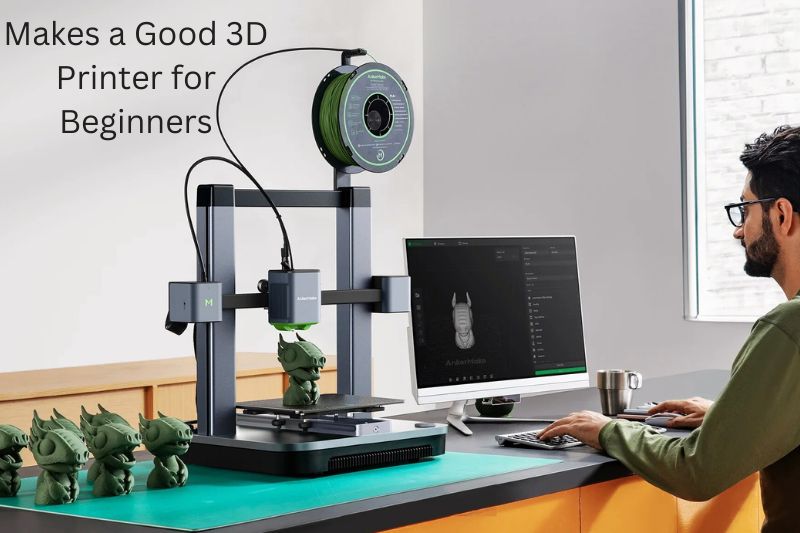
What Makes a Good 3D Printer for Beginners?
When choosing a 3D printer for your use, there are many things to consider. Consider the following factors for the smoothest introduction to the 3D printing world.
Ease of Setup and Use
For beginners, there are ready-to-use 3D printers that work right out of the box. Many reports highlight their ease of use and reliability. Whether you’re using basic tools or more advanced features, understanding the fundamentals is key. Some models are simple to set up, require minimal assembly, and offer features like automatic bed leveling. It’s also worth noting that not every print will succeed at first—even with preconfigured settings and beginner-friendly interfaces. If you’re planning to start a workshop or side hustle, choosing the best 3d printer for small business can save time and reduce frustration.
Affordability Without Compromise
3D printing can be pretty expensive, but you don’t have to break the bank if you are just getting started. Look for low-cost printers that are highly rated and priced under $500. A lightweight printer in the wallet shouldn’t be a surprise. Consider printers with stronger bodies, heated plates, and larger printing volumes. Creality Ender 3 series models offer a combination of great features and low prices, making them ideal for new users looking to create 3D prints without breaking the bank.
Consistent Performance
Developing trust and understanding of a practice requires novice users to produce reliable outcomes. The best printers have solid construction and consistently meet the desired parameters even after multiple cuts and operations. Properly built build plates, quality extruders, and good cooling systems ensure good output. Dual gear feeders or direct drive systems can reduce common problems like filament tangling, allowing first-time users to have a better experience.
Customer Support and Community Resources
Starting out isn’t easy, and you will have many questions. Because of this, it’s critical to choose a brand with good after-sales support. Companies may also provide tutorial videos, replacement materials, and step-by-step instructions. Additionally, you should look for printers with a strong user community. User forums, Facebook groups, and YouTube channels are all good places to find instructions, modifications, and help if you are part of a considerate and supportive community.
Top 5 Beginner-Friendly 3D Printers in 2025
| 3D Printer | Overview | Best For |
| Creality Ender 3 V3 SE | This affordable printer combines ease of use with reliable performance. It offers features like auto-bed leveling and straightforward setup, making it ideal for new users. | Affordability and quality are the top priorities for hobbyists. |
| Anycubic Kobra 3 Combo | Its user-friendly touchscreen and auto-leveling make it a hassle-free option for beginners exploring creative possibilities. The Kobra 3 Combo supports multi-filament printing. | Advanced designs and filaments are available for creative users. |
| Bambu Lab A1 Mini | This ultra-compact printer features multicolor printing options and intuitive settings, making it ideal for smaller spaces and users who prioritize convenience. | Beginners with limited space need top-notch speed and multicolor printing. |
| AnkerMake M5C | The M5C is a beautifully designed printer with a user-friendly software interface that provides fast printing and high-quality results. | Business startups or professionals looking for quick, high-quality results. |
| Prusa MK4 | Prusa MK4 is a premium 3D printer, but its robust design and detailed print quality make it a worthwhile investment for beginners. | Beginners with a high budget looking for a reliable, advanced upgrade option. |
1. Creality Ender 3 V3 SE
Affordable and Reliable
At under $200, the Creality Ender 3 V3 SE is an excellent value for beginners. It’s reliable and delivers consistent results.
Hassle-Free Setup
The printer’s CR Touch sensor automatically levels the bed, so you don’t have to worry about getting the first layer right.
With just a few screws and minutes of your time, the majority of the work is already done for you.
Easy to Use
Color screen and uncomplicated controls provide user-friendliness in loading filament and starting prints.
Impressive Print Quality
The prints are very smooth and high-quality, and the printer can handle complex and straightforward prints without deteriorating in quality.
Great for Beginners
The Ender 3 V3 SE printer is low-cost and easy to use, making it ideal for beginners in 3D printing. It facilitates exploration, learning, and creation without wasting time.
2. Anycubic Kobra 3 Combo
Anycubic Kobra 3 Combos are designed for beginners. It’s convenient to install and has great features.
Multi-Filament Printing
With four filaments available simultaneously, you can print vivid colors or combine different types of materials, such as flexible and strong filaments, for elaborate and distinct projects.
Easy for Beginners
- Quick Setup: Most parts are pre-assembled. It takes only 10 to 20 minutes to get started.
- Automatic Bed Leveling: The printer adjusts so prints stick perfectly to the base.
- Simple Touchscreen: The large screen makes it easy to control and monitor your prints.
Reliable Performance
The sturdy frame allows PLA, ABS, PETG, and TPU materials to be printed easily and accurately.
Great for First-Time Users
The machine is user-friendly and produces excellent results. It is perfect for those who want to unleash innovation and create brilliant designs right from the beginning, as well as advanced modeling for beginners.
3. Bambu Lab A1 Mini
The Bambu Lab A1 Mini is ideal for beginners, offering a compact design, rapid speed, and an affordable price.
Compact and Simple Setup
A compact design makes it easy to store. It arrives almost fully assembled, allowing you to start printing in just 20 minutes.
Multicolor Printing for Creativity
The AMS Lite add-on lets you print in four colors. Switching filaments is simple, so beginners can easily explore creative designs.
Speed and Quality
The A1 Mini is fast, with speeds up to 500mm/s. It prints objects quickly without losing quality, making the details sharp and accurate.
Easy Features for Beginners
It uses a direct-drive extruder and auto-bed leveling. The heated print bed makes object removal easy. It handles PLA, TPU, and PETG filaments well.
Eco-Friendly Design
It reduces filament waste with proper settings. The AMS Lite works with third-party filaments, adding flexibility.
Affordable Price
The base model costs $299, and the combo with AMS Lite is $459. This is an excellent deal for multicolor printing.
Things to Note
- Small build size (7 x 7 x 7 inches).
- Some filament waste during color changes.
- Tiny touchscreen interface.
Final Thoughts
Bambu Lab A1 Mini is a good 3D printer for beginners. It is quick, simple to use, and low-priced, and its multicolor function inspires creativity.
4. AnkerMake M5C
AnkerMake M5C is an excellent beginner printer. It is very easy to use, quick to print, and efficient. It prints at 500 millimeters per second, which is faster than any level-one printer. The hot end is made of metal and can be heated up to 300 degrees centigrade. It is compatible with PLA, PETG, and TPU filaments.
An auto-bed leveling feature on this printer assesses 49 areas of the bed to facilitate print quality. You can control it using a splendid mobile or computer application.
Who Will Love This Printer?
- First-Time Users: It’s easy to set up and simple to operate.
- Users Who Need Speed: It prints fast without losing quality.
- Those Who Want Great Quality: You get smooth, professional-looking prints.
Any Downsides?
Some people might be unable to use the device because it lacks a screen. Additionally, it requires an app, so some customization options may not be available.
AnkerMake M5C is an excellent tool for beginners interested in 3D printing. It is very fast, easy to use, and produces high-quality prints.
5. Prusa MK4
Prusa MK4 represents a good entry-level 3D printer option. Although it costs more, it boasts excellent characteristics and can provide good long-term returns.
Why It Stands Out
- High-Quality Prints: The MK4 delivers detailed and smooth results, even for complex designs.
- Easy to Use: The fully assembled option allows beginners to start quickly, and the automated features simplify printing.
- Perfect First Layers: Its auto bed leveling adjusts everything for you. No manual work is needed.
- Prints Many Materials: It prints with PLA, ABS, PETG, and even advanced filaments like carbon-filled options.
What Makes It Special
- Nextruder Technology: The new extruder grips filament more securely and features a quick-swap nozzle for easy maintenance.
- Quiet Printing: It operates quietly, ideal for home use.
- Wi-Fi Connectivity: You can control the printer remotely and use popular slicer software like PrusaSlicer.
- Durable Build: Its sturdy aluminum frame ensures consistent performance over time.
Who Should Choose the MK4?
This 3D printer is ideal for advanced hobbyists or anyone seeking a high-quality, durable 3D printing solution. The advanced facet and simple interface will also appeal to novice and seasoned users. It’s an excellent choice for someone seeking quality and usability at $1,099 pre-assembled (or $799 as a kit).
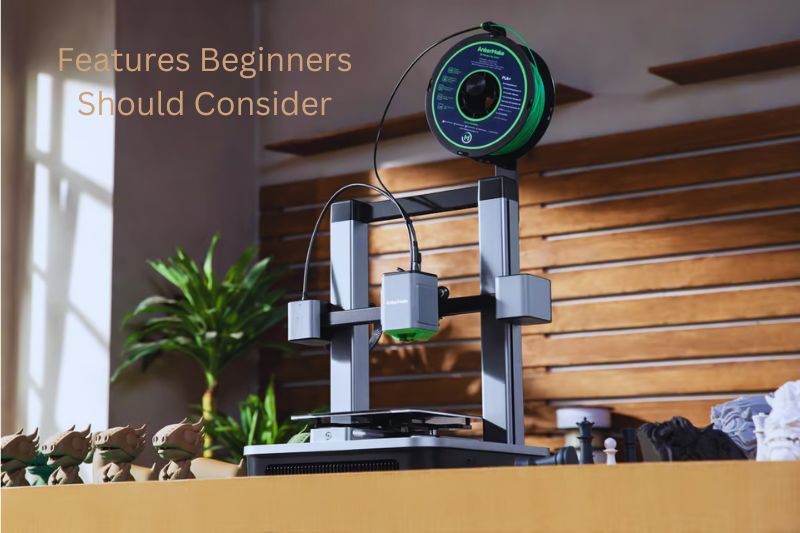
Unique and Under-Discussed Features Beginners Should Consider
AI and Smart Features for Error-Free Printing
3D printers can simplify printing with artificial intelligence. Bambu Lab printers that use LIDAR technology to ensure the first layer is correct can identify and fix specific problems during the printing process. These characteristics help novice users avoid errors and material loss by preventing prints from being printed where they shouldn’t be. Spaghetti Detection and other tools prevent incorrect printing.
Silent Operation for Home Use
The Ender 3 V2 printer features a silent motherboard, making it ideal for apartment dwellers or those sharing space with others. Most printers are pretty loud, but some are designed to reduce that noise. Having a quiet printer at home can make printing more relaxing for you.
Portability and Compact Design
The Bambu Lab A1 Mini is a compact, lightweight machine suitable for flats or schools that cannot accommodate larger 3D printers.
Multi-Material Printing from the Start
The Anycubic Kobra 3 uses PLA, TPU, or wood substitute filaments, which makes it possible to print flexible phone cases or strong tools.
Energy Efficiency
Although 3D printing is time-consuming and can increase your electricity bills, some models turn off automatically after finishing a task. In contrast, others only heat the areas that need heat, making them cost-effective and eco-friendly.
How Growth Potential Matters
A good printer for beginners should support the progression of their skills. There are several models with improvements, sensitive nozzles, and an expandable printing area, such as the Prusa MK4. Your printer can last longer if you add features as you learn.
The properties of 3D printing make it easier for beginners to learn the technology. Choosing a printer with these features will make your 3D printing experience easy and fun by avoiding issues, saving space, and opening up a wide range of creative options.
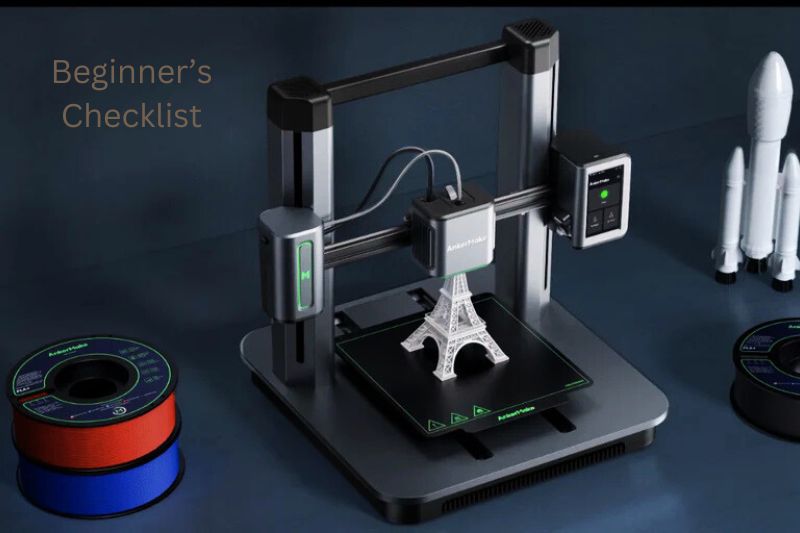
A Beginner’s Checklist for Buying a 3D Printer
The process of buying your first 3D printer can be both exciting and intimidating. To assist you, we’ve outlined the elements that beginners should remember.
1. Technology and Filament Type
For beginners, the two main types of 3D printers are FDM (Fused Deposition Modeling) and resin printers (SLA/DLP/LCD).
- FDM printers are affordable, versatile, and ideal for creating functional items such as tools and models. They build objects by layering filament (such as PLA, PETG, and ABS).
- For jewelry or prototypes, resin printers use liquid resin cured by UV light to create highly detailed objects. These printers require more maintenance.
Beginners should use an FDM printer with standard PLA filament for hassle-free printing.
2. Build Size and Space
Consider the size of the items you intend to print. Printer build volumes are measured in XYZ dimensions (width, depth, and height).
- A printer with a smaller build volume, such as one of 6-8 inches, is sufficient for small projects such as figurines or parts.
- For larger designs or functional items, seek build sizes of 10 inches or more.
3D printers require a stable surface and room for extras like filament spools or resin tanks. Make sure you have space for your printer.
3. Connectivity Options
How you send files to your printer matters:
- For standalone models, USB or SD cards let you load files directly.
- You can send designs wirelessly with Wi-Fi-enabled printers for convenience, especially if your printer is in another room.
Beginners should consider a printer with both SD card and USB options for flexible connectivity without complicating matters.
4. Software Compatibility
The slicing software prepares your 3D model for printing by optimizing it for the printer’s capabilities.
- Selecting a printer with excellent community support and user-friendly software is crucial.
- Learning about open-source printers will give you more opportunities to experiment.
5. Safety Features
Safety is vital, especially if you’re a beginner or plan to use the printer at home. Look for:
- Enclosed frames to keep hot components out of reach.
- Auto-shutoff features that stop the printer once a task is done.
- Non-toxic filaments like PLA, which don’t emit strong fumes.
Tip for beginners: Resin printers require more care. Always wear gloves when handling resin and ensure good ventilation during printing.
6. Budget Considerations
The cost of owning a 3D printer isn’t just about the initial purchase. Consider:
- Entry-level FDM printers start at $300 and are budget-friendly in the long run.
- Resin printers often have higher running costs due to the price of resin and post-processing tools.
- Factor in additional costs like filaments, spare parts, or maintenance tools.
Tip for beginners: Start with an affordable FDM printer and standard PLA filament to keep initial costs low.
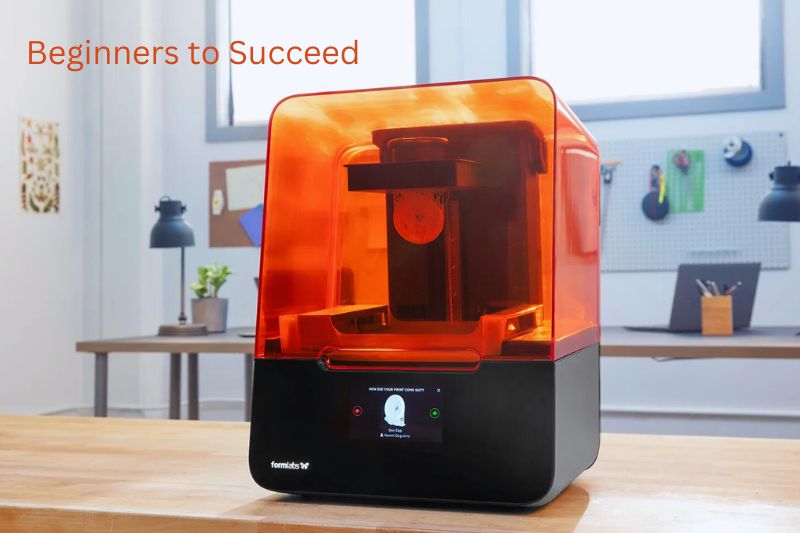
Tips for Beginners to Succeed in 3D Printing
Start Simple
The first step is to print out your design, and then you can move on to more complex designs. To get started, consider printing coasters or keychains, as they are easy to produce and minimize material waste. Get used to the printer by taking slow, simple steps.
Experiment with Filament
PLA filament is easy to use and comes in a variety of colors. After a few prints, PETG will be stronger, while TPU will be more flexible. You should test the filaments on a small print to see how they react. Please keep them in a safe environment.
Learn Basic Maintenance
Clean your nozzle before starting and after a print to ensure better adhesion. Acetone will help your print head stick better. Be sure to securely fasten all moving parts and screws to avoid print problems. When printing, ensure your bed is level to avoid any issues.
Join a Community
Explore Reddit’s /no-sleep or Facebook groups dedicated to 3D printing for more information on this unique art form. Communities offer a variety of tips, designs, and advice, as well as opportunities to learn and grow. As well as providing motivation, they can be enjoyable to print.
Upgrade Gradually
Take your time before buying upgrades. You can upgrade your nozzles or try different filaments once you’re comfortable with your printer. To reduce issues, use a filament sponge. Learn about slicing software to always improve prints and save money.
The best way to enjoy 3D printing is to take your time, ask for assistance if needed, and learn gradually.
Wrapping Up
For a beginner in 3D printing, selecting your first 3D printer can be challenging. Choose a printer within your budget that is user-friendly, cost-effective, has a low set-up time, and is reliable. Select a printer that is easy to use, cost-effective, and produces high-quality prints.
Moreover, you can benefit from features such as auto-bed leveling and a support system. The best printer for you is the one that fits your strategic vision. Feel free to start from scratch, experiment, and enjoy the great opportunities 3D printing offers.
Frequently Asked Questions
What type of 3D printer is best for a beginner?
The FDM (Fused Deposition Modeling) printer is generally best for beginners. They are more affordable, easier to maintain, and utilize safe and versatile plastic filaments (like PLA), offering a much wider community for support and troubleshooting.
What are the most important features to look for in a beginner printer?
Prioritize Ease of Use. Look for:
1. Automatic Bed Leveling: This is the most crucial feature, as a perfect first layer is key to successful printing. It eliminates frustrating manual calibration.
2. Pre-Assembled or Quick Setup: Choose a printer that requires minimal assembly so you can start printing right out of the box.
3. Strong Community Support: A large online community (forums, Facebook groups, YouTube) is essential for getting quick help and learning tips.
4. Decent Build Volume: A standard build area of around 220 x 220 x 250 mm is sufficient for most beginner projects.
What is ‘Build Volume’?
Build volume is the maximum physical size (width x depth x height) of an object that your 3D printer can create. A larger build volume enables you to print larger models or batch-print multiple small parts simultaneously.
How do I maintain my 3D printer?
Basic maintenance is key:
1. Clean the Build Plate: Wipe the bed with isopropyl alcohol or soap and water after every few prints to ensure good adhesion.
2. Store Filament Properly: Keep filament sealed in a dry place (ideally with desiccant) when not in use, as humidity can ruin the material and cause bad prints.
3. Keep Screws and Belts Tight: Occasionally check that the belts on the X and Y axes are taut and that all screws are securely fastened.
Is it safe to leave my 3D printer running unattended?
Modern 3D printers are generally safe, but it is not recommended to leave them unattended for long periods, especially for very long prints. Some advanced safety features to look for include enclosed frames (for temperature stability and safety) and fire-resistant components.
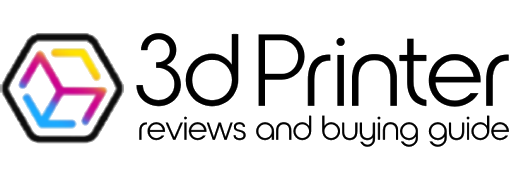
Comments are closed.